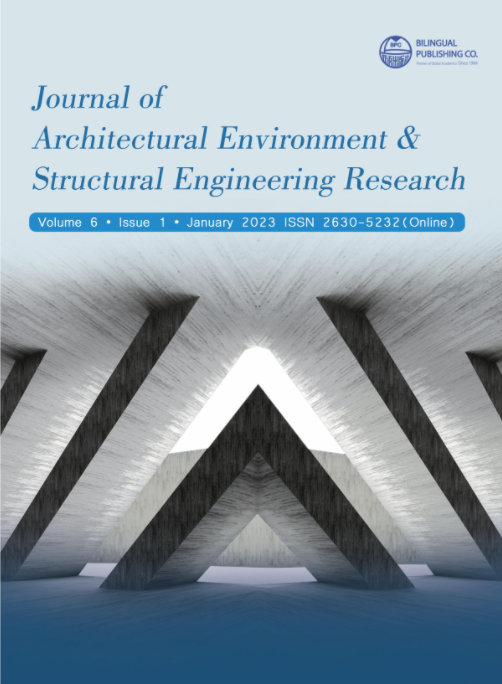-
371
-
223
-
185
-
181
-
176
Geometric Study of Two-Dimension Stellated Reentrant Auxetic Structures to Transformable Architecture
DOI:
https://doi.org/10.30564/jaeser.v6i1.5436Abstract
Transformable architecture is totally linked to the study and knowledge of geometry. There are some materials in nature, whose geometric invariants establish equivalent structural behavior regarding the scalar transformations, developing different spatial typologies according to dimensional variation. Auxetic materials are characterized by their negative Poisson’s ratio. The can change their geometric configuration from a line to a surface, and from a surface to a volume or spatial framework. This paper is based on establishing and comparing those stellated reentrant auxetic geometries to be able to build new spaces defined by their capacity to architectural transformation, studying analytically geometric properties of stellated reentrant auxetic structures that, from the molecular to the macroscopic level, can be part of the architecture construction. In this investigation a comparative study by means of CAD of stellated reentrant auxetic patterns has been realized. A Computer Aided Design study of stellated reentrant auxetic structures will be realized to use them to architecture. The geometric behavior of the different stellated reentrant auxetic patterns is analyzed from the developed study to generate a systematic comparison, evaluating properties of these forms, such as their maximum achievable area reductions in relation with the total length of bars of the structure, in order to obtain a growth factor.
Keywords:
Transformable; Architecture; Geometry; Auxetic; Stellated; Reentrant; CAD; Growth factorReferences
[1] Lakes, R.S., 1987. Foam structures with a negative Poisson’s ratio. Science. 235, 1038-1040.
[2] Evans, K.E., 1991. Auxetic polymers: A new range of materials. Endeavour. 15, 170-174.
[3] He, C., Liu, P., McMullan, P.J., et al., 2005. Toward molecular auxetics: Main chain liquid crystalline polymers consisting of laterally attached para-quaterphenyls. Physica Status Solidi. 242, 576-584.
[4] Liu, Y., Hu, H., 2010. A review on auxetic structures and polymeric materials. Scientific Research & Essays. 5, 1052-1063.
[5] Griffin, A.C., Kumar, S., Mc Mullan, P.J., 2005. Textile fibers engineered from molecular auxetic polymers. National Textile Center Research Briefs-Materials Competency. 1-2.
[6] Álvarez, M.D., 2019. Tensioned auxetic structures manual calculus. Journal of Architectural Environment & Structural Engineering. 2(1), 23-31.
[7] Scarpa, F., Jacobs, S., Coconnier, C., et al., 2010. Auxetic shape memory alloy cellular structures for deployable satellite antennas: Design, manufacture and testing. EPJ Web of Conferences. 6, 27001.
[8] Bianchi, M., Scarpa, F., Smith, C.W., 2010. Shape memory behaviour in auxetic foams: Mechanical properties. Acta Mater. 58, 858-865.
[9] Tan, T.W., Douglas, G.R., Bond, T., et al., 2011. Compliance and longitudinal strain of cardiovascular stents: Influence of cell geometry. Journal of Medical Devices. 5, 041002.
[10] Friis, E.A., Lakes, R.S., Park, J.B., 1988. Negative Poisson’s ratio polymeric and metallic foams. Journal of Materials Science. 23, 4406-4414.
[11] Álvarez, J.C., Díaz, A., 2012. Comparative study of auxetic geometries by means of computer-aided design and engineering. Smart Materials and Structures. 21(105004), 1-12.
[12] Álvarez, M.D., Anaya, J., 2018. Development of reentrant hexatruss structures to apply to architecture. Journal of Construction. 17(2), 209-214.
[13] Álvarez, M.D., 2020. A comparative study of the pliability of separate auxetic architectonic structures by means of CAD. Advances in Sciences and Engineering. 12(1), 41-46.
[14] Anaya, J., Álvarez, M.D., 2018. Estructura reticular transformable. Spanish Patent. ES 2 659 841 A1.
[15] Anaya, J., Álvarez, M.D., Serrano, R., 2018. Barra regulable mediante sistema de presión para estructuras reticulares. Spanish Patent. ES 1259645 U; U 202032627 (2).
[16] Anaya, J., Álvarez, M.D., Serrano, R., 2018. Sistema de unión para estructuras reticulares móviles. Spanish Patent. ES 1238524 Y; U 201931716 (8).
[17] Álvarez, M.D., 2019. Transformable geometries of architecture between the years of 1950 and 2015. Journal of Architectural Environment & Structural Engineering Research. 2(2), 6-17.
[18] Thompson, D., 2003. Sobre el crecimiento y la forma (No. 591.49 THO).
[19] Álvarez, M.D., Anaya, J., 2018. Review of contemporary architecture projects based on nature geometries. Revista de la construcción. 17(2), 215-221.
[20] Álvarez, M.D., 2020. Tensegrities and tensioned structures. Journal of Architectural Environment & Structural Engineering Research. 3(3), 10-16.
[21] Álvarez, M.D., 2022. Knot types used by transformable and rigid linear structural systems. Journal of Architectural Environment & Structural Engineering Research. 5(2), 1-15.
Downloads
How to Cite
Issue
Article Type
License
Copyright © 2023 Mª Dolores Álvarez Elipe

This is an open access article under the Creative Commons Attribution-NonCommercial 4.0 International (CC BY-NC 4.0) License.




 Mª Dolores Álvarez Elipe
Mª Dolores Álvarez Elipe





